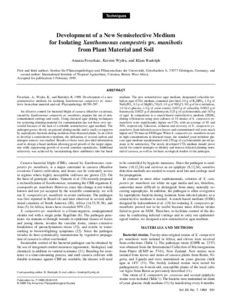| dc.contributor.author | Fessehaie, A. |
| dc.contributor.author | Wydra, K. |
| dc.contributor.author | Rudolph, K. |
| dc.date.accessioned | 2019-12-04T11:22:29Z |
| dc.date.available | 2019-12-04T11:22:29Z |
| dc.identifier.citation | Fessehaie, A., Wydra, K. & Rudolph, K. (1999). Development of a new semiselective medium for isolating Xanthomonas campestris pv. manihotis from plant material and soil. Phytopathology, 89(7), 591-597. |
| dc.identifier.issn | 0031-949X |
| dc.identifier.uri | https://hdl.handle.net/20.500.12478/4017 |
| dc.description.abstract | An effective control for bacterial blight of cassava (Manihot esculenta), caused by Xanthomonas campestris pv. manihotis, requires the use of non-contaminated cuttings and seeds. Using classical agar plating techniques for screening planting material for contamination has not been very successful because of the lack of a reliable semiselective agar medium. The pathogen grows slowly on general plating media and is easily overgrown by saprophytic bacteria during isolation from diseased plants. In an effort to develop a semiselective medium, the utilization of several carbon and nitrogen sources was studied. Results of these tests provided information used to design a basal medium allowing good growth of the target organism while suppressing growth of several common saprophytes. Additional selectivity was achieved by incorporating three antibiotics into the basal medium. The new semiselective agar medium, designated cefazolin trehalose agar (CTA) medium, contained (per liter) 3.0 g of K2HPO4, 1.0 g of NaH2PO4, 0.3 g of MgSO4·7H2O, 1.0 g of NH4Cl, 9.0 g of D(+)-trehalose, 1.0 D(+)-glucose, 1.0 g of yeast extract, 0.025 g of cefazolin, 0.0012 g of lincomycin, 0.0025 g of phosphomycin, 0.25 g of cycloheximide, and 14.0 g of agar. In comparison to a starch-based semiselective medium (SXM), plating efficiencies using pure cultures of 10 strains of X. campestris pv. manihotis were significantly higher on CTA, with an average of 85 and 50%, respectively. Likewise, isolation and recovery of X. campestris pv. manihotis from infected cassava leaves and contaminated soil were much higher on CTA than on SXM agar. When X. campestris pv. manihotis occurs in high concentrations in diseased tissue, the standard yeast trehalose glucose agar medium supplemented with 250 μg of cycloheximide per ml appears to be satisfactory. The newly developed CTA medium should prove useful for control strategies to identify and remove infected planting material of cassava, as well as for basic ecological studies of the pathogen. |
| dc.description.sponsorship | Federal Ministry for Economic Cooperation and Development, Germany |
| dc.language.iso | en |
| dc.subject | Xanthomonas Campestris Manihotis |
| dc.subject | Cassava |
| dc.subject | Manihot Esculenta |
| dc.title | Development of a new semiselective medium for isolating Xanthomonas campestris pv. manihotis from plant material and soil |
| dc.type | Journal Article |
| dc.description.version | Peer Review |
| cg.contributor.affiliation | Institut für Pflanzenpathologie und Pflanzenschutz der Universität, Germany |
| cg.contributor.affiliation | International Institute of Tropical Agriculture |
| cg.coverage.region | Africa |
| cg.coverage.region | West Africa |
| cg.isijournal | ISI Journal |
| cg.authorship.types | CGIAR and advanced research institute |
| cg.iitasubject | Plant Diseases |
| cg.iitasubject | Cassava |
| cg.iitasubject | Soil Information |
| cg.iitasubject | Plant Health |
| cg.accessibilitystatus | Limited Access |
| local.dspaceid | 99303 |

